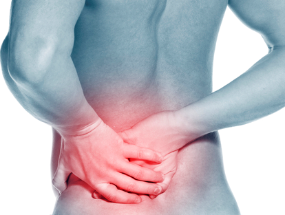
Physical Therapy
Low Back Pain
Lower back pain is probably the most common complaint that people seek therapy for. In fact, about 80% of adults suffer from lower back pain at some point in their life.
Back pain can have multiple causes. Most often, it stems from an injury, like lifting something too heavy or bending over wrongly that results in a muscle strain (protective muscle spasm) of the back muscles and our deep hip flexor, the psoas muscle. Resting in the static back position with both legs up on a chair (see picture) for 10-15 minutes several times per day is usually a good first aid together with gentle movement like walking. Extensive bed rest should be avoided. Also taking a NSAID (non-steroidal anti-inflammatory drug) in the acute phase can help. Some people prefer ice or heat.
Most of the time this kind of back pain will decrease within a few days but it helps to get a few treatments after the immediate acute onset to relax the protective muscles spasm further, mobilize any spinal restrictions and address longstanding muscle imbalances that were most likely the underlying cause anyway. Untreated back pain can go on for weeks and, if the underlying muscle imbalances are never addressed, can lead to people having pain episodes more and more often with decreasing pain free intervals in between. I also like to teach people better ways to sit, stand, lift and bend to prevent future injuries and a back self care program.
Some people end up with a more severe pathology like a “slipped” (herniated) disk or spinal stenosis (narrowing of the spinal column). But even with those conditions it is good to try manual therapy and exercises first. Many times balancing out muscle imbalances and doing the right exercises to support that can calm the whole condition down again and more invasive approaches like epidural injections and surgery can be avoided. Good follow-through with exercises and self care is a key here. Even so, sometimes, with all good intentions, surgery can’t be avoided. But what I see from my long practice experience of over 35 years is that this is needed much less often than most people believe.
Shoulder / neck pain
Also called by one of my instructors the famous “Shneck” pain, it is most likely the 2nd most common reason why people seek therapy. And with the ever increasing computer, tablet and cellphone life style, almost everybody seems to suffer from it. So yes, I hate to repeat what you probably have heard everywhere else: it has something to do with our posture. But how do we recover a better posture when our head is a foot in front of our shoulders?
What I have seen as the most effective approach is to first release all of the painful protective muscle spasms in the area and then mobilize any restricted joint motion with manual therapy. At that point, most people start to be able to get their head back on top of their shoulders again. Once that is accomplished, postural exercises actually start to feel good.
If you wake up with acute neck pain where you can hardly turn your head any more, don’t force it to move. I suggest wrapping a folded pillow case around your neck at night like a soft collar. That will keep your neck in a neutral position and help it to get better faster. Taking a NSAID (non-steroidal anti-inflammatory drug) for a few days can help to calm it down too.
Only a small number of patients have severe neck pain with referred upper extremity pain that is caused by a herniated disk and does not respond to therapy. These cases often get better with steroids or an epidural injection and don’t require surgery.
Questions About Our Treatments?
Call us at (503) 890-9107.



